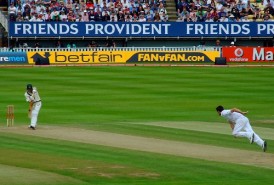Review: The Ashes
Ewen Day-Collins |
While the men were competing in the 2013 Ashes (Part One), the women were partaking in a similar though revolutionary competition. In many senses, the contrast serves to highlight the differences between where cricket has come from, and where it is going.
The men slogged through a five-match series over many months. The women trialled a version that the men may soon be forced to adopt. This version combines cricket’s trinity – Test, 50-over, T20 – and places them in one contest. Six points are gained for winning the sole Test match (or two for a draw); and two points for each of the other games, with three T20s and three ODIs being staged. The marginalisation of longer Test series (just two over three matches in 2013 so far), and the domination in most parts of the subsequent ODI series, leaves this option as significantly preferable to the inexorable slow death of Test cricket.
That death is, unfortunately, occurring outside of the Ashes, which is unique in retaining a five-match structure. And, currently, we are merely half-way through a 10-match epic that resumes on 21 November.
So far, this series has hardly equalled its billing. This is, primarily, for two reasons. First, all Ashes in the near future fall in the shadow of 2009 and in the even greater shadow of 2005, series that offered the profound competitive cadences that can make only cricket so gripping. Secondly, this current England side is too good for Australia to handle, but not good enough to inspire the awe that watching truly great teams, even when thrashing the weakest opposition, can bring.
This series had good moments, but too many came in the earlier stages of it; 2005 and 2009 both had a great crescendo to the final Test – with exciting contests interspersed – that left the entire Ashes on the edge of a huge, sharp knife. 2013’s stellar moment came immediately, in Nottingham.
We weren’t to know that Ian Bell’s 109 in England’s second innings was to foreshadow his decisive contributions. We had even less of an idea about Ashton Agar, a 19-year-old who smashed his way to 98 at number 11 and constructed a tenth-wicket partnership of 163 with Philip Hughes. Many records were broken. Not that it fazed him, according to his dad, John: “We went for an Italian meal and Ashton’s attitude was that it was just another game to him.” Just another game? Really?
Nor were we to predict the tense conclusion to the first Test. Ultimately, England won by just 14 runs. The wicket that clinched victory owed to a DRS (Decision Review System) hot-spot that was barely visible on the edge of Brad Haddin’s bat. The crowd erupted. One down, four to go.
Indeed, DRS was the biggest loser of this series. Incorrect decisions were reached on review: overturning a correct decision brings the game into farce. Yet whilst certain parts of the system remain in the judgement of the umpire this is inevitable. The hot-spot equipment is not infallible, and more importantly the umpires interpreting it most certainly aren’t, but its use increases the percentage of accurate decisions. Some dislike the questioning of an umpire’s decision, but anyone has a right to question a decision if it is demonstrably wrong. However, as DRS is there to remove the howler, the number of reviews should be reduced to one an innings per team so captains only employ DRS when they are sure an umpire has made a mistake. Two challenges allows for speculation on tight decisions, and the farce that follows.
The excitement of the first Test was not continued at Lord’s. Bell sustained his form with a second century, and Joe Root placed himself on the Lord’s honours board by scoring an impressive 180, though could not replicate this again; Root averaged 37.66 for the series, which does not fulfil the unmerited expectation placed on him but does show an impressive consistency of run-scoring even amid the pressure of an Ashes debut. He did not crumble as Ravi Bopara did four years ago. England eventually won in Lord’s by 347 runs, which stimulated expectation of further overwhelming dominance that, perhaps surprisingly, did not arise.
At Old Trafford and at the Oval Australia made huge first innings totals (of 527 and 492 respectively), that England had no reply to. In Manchester, England were fortunate that rain intervened on the last day just after lunch; at 37-3 the situation was perilous. Though they retained the Ashes, and completed this task in the quickest time possible (after three matches) for just the second time (the other was the 1928-9 series), it was a disappointing manner in which to triumph.
In London, at the final Test, Shane Watson and Steve Smith both scored glittering hundreds in the first innings. Both were significant: Watson’s in that it signalled number three may be his most prosperous position; Smith’s in that it showed the selectors were correct in sticking with him and also that Australia’s depth of batting is not quite as shallow as many had thought.
England, in response, were lethargic and painfully slow: the top five scored 228 runs off 960 deliveries. It was only owing to Michael Clarke’s desire to win, leading him to declare and set a gettable target mid-way through the final day, that England’s lethargy was mitigated. Incidentally, England drew on the two occasions they lost the toss.
Punctuating these two matches was Stuart Broad’s scintillating performance at Chester-le-Street in Australia’s final innings. He removed numbers seven, eight, nine and 10 in a six-wicket haul that saw England win by 74 runs. Ryan Harris had claimed seven wickets to prove that, when not injured, he is superb.
Ian Bell made another century but, interestingly, again fell early-on after passing the 100 mark, this time for 113. When at their peak two years ago, this England side – motivated by the doctrine of batting coach Graham Gooch – were ruthless in their pursuit of “daddy hundreds”. Only Root scored one, at Lord’s. This suggests that England have lost this ruthless streak. The reason for its decline is unlikely to be complacency; it could just be down to a group of cricketers many of whom are old and deteriorating, or perhaps a result of Andrew Strauss’ departure. It certainly gives succour to Australia and their hopes of performing better later this year.
And while Anderson was brilliant for the first half of the series, and Broad and Swann for one match each, the bowling – like the batting – was hardly the cohesive, penetrating combination that visited Down Under last time. Indeed, the decision to call-up Chris Woakes and Simon Kerrigan – neither of whom impressed – for the final Test demonstrates a lack of reserves beyond an underperforming front three. In contrast, Australia will hopefully welcome back James Pattinson and – though perhaps more doubtful – Pat Cummins. Both have shown talent far surpassing England’s youngsters, further magnified as Steve Finn has experienced a disappointing year.
Perhaps as a result of an underwhelming series on the field, individual moments were scrutinised more than usual. We have already discussed DRS; thankfully, the aftermath of David Warner’s punch on Joe Root had subsided once the action began. But two incidents in particular caused a flurry of comment during the series. Both have profound implications for the game and warrant further exploration.
The first is the decision in the final match to end the game owing to ‘bad light’. As the umpires had previously called players off early, notably on the fourth day of the third Test which halted Australian momentum, the law dictates that the same had to happen even with the game in the closing stages, England requiring 21 runs with just 24 balls remaining. This shows a fundamental problem at the heart of cricket: it has forgotten about the customer, who should be its primary focus.
The main point is that there is no such thing as ‘bad light’ when multiple, high-voltage, super-beam floodlights illuminate the ground – sufficiently, indeed, for numerous day-night games to be played. For a game to be just cut off (in both instances) when thousands of spectators watching and listening to the game around the world want it to continue is utterly ridiculous and fatal for Test cricket’s future, which must do more to satisfy a dwindling customer base.
Many have argued the solution is to hand the decision on bad light to the batsman. But what if, in the same circumstances, Australia had had one wicket left and the English bowlers had been closing in with a few overs left? The Aussie batsmen would have chosen to finish the game, despite all the Oval spectators wanting it to continue. The answer is for floodlights to be mandatory for all international grounds and to keep playing until the allotted 90 overs per day is completed, even if it means playing under floodlights (which demonstrably does not compromise a batsman’s safety, the only credible reason not to play). This is what the customer, who is the absolute and undivided priority, deserves. It is a lesson cricket needs to learn, and quickly.
The second incident was Stuart Broad’s refusal to walk despite edging the ball clearly off the gloves of Haddin and into the palms of Clarke at first slip. The umpire was unmoved. Broad should have walked, as every batsman should if he knows he is out. This was about right and wrong. It was damning indeed that the vast majority of ex-players failed to recognise this fact. It poses severe challenges to maintaining basic levels of decency at the youth level when those at the top fail to, especially as much of sport’s societal worth surrounds instilling values of respect, honesty and fair play that can be transferred to everyday life.
Some professionals retain this belief, including Graeme Swann, who complained of Dilruwan Perera’s decision not to walk in March last year by calling him a “cheat”. He said of Perera’s non-walking: “It was very difficult to take because it was so blatantly out … The thing that annoyed me was that the batsman stood there knowing 100 per cent he was out but chose to cheat.
“It was just cheating but we live in an age where cheating is accepted in our game. If you don’t walk and get away with it no-one seems to say anything. I don’t agree with that. I understand when people say they will leave it to the umpire but again I question their morality to be honest. The same people who say ‘leave it to the umpire’ will then say you have to take their word if they catch it. It’s horrific double standards and it’s against the spirit of the game. If you know you’re out then you walk off the field in my view. This is an ideal world I’m talking about.” It shouldn’t have to be.
The numerous apologists, including many reading this now, will continue to assert that the end result is more important than the way in which it is achieved. Martin Samuel, the chief sports writer of the Daily Mail, puts it well in defying this zeitgeist: “There is such a thing as basic, common decency. Being a good sport, being a straight up guy. Golfers, snooker players, call penalties on themselves. Why not cricketers? It is not as if we are at war here. These are ball games. If false information can save several thousand lives in battle, that is justified. If you have edged it to first slip in a game of cricket, just go. It really isn’t that important. Indeed it is remarkable, quite preposterous, that there should even be a debate…
“Yes, there will be grey areas. Times when the fielder isn’t sure whether the ball was grounded or not; super fine edges that may have come from the bat or the pad. This wasn’t like that. Stuart Broad knew what he had done, so did everybody on the field, bar the one man with the power to act – umpire Aleem Dar. [Dar] was made to look a fool and he did not deserve that. It should not be that referees, umpires and judges are left embarrassed by honest, inadvertent, human error…
“Some of the caveats are simply irrelevant. It does not matter that Australia used at least one of their referrals unwisely. Maybe they will not chase specious lbw decisions in future and reserve their challenges for moments of utter certainty. This is a sub-plot though, not the main event. This is not a test of the DRS system but of the basic principles of right and wrong … England would have beaten [Australia] fair and square. They [will] just have to settle for square, instead.”



-84x127.jpg)

I’ve read a number of articles asserting that the Ashes is now “unique” as being a five match series. Am i the only person who has bothered to notice that England-India next summer is also being contested over 5 tests?
Comment by greg | 12:00am BST 1 September 2013